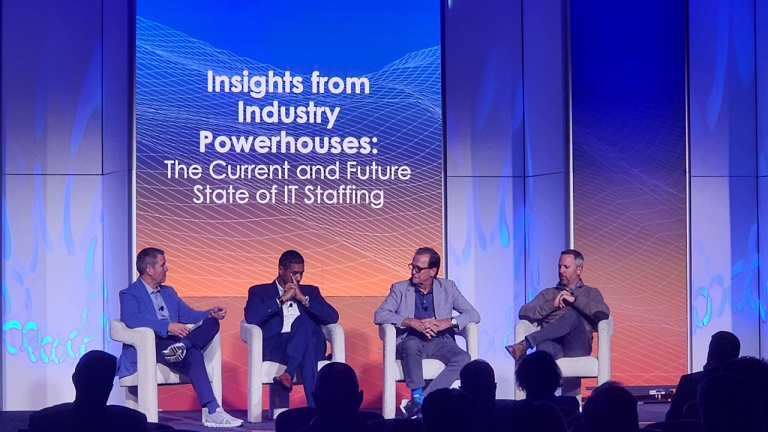Maximizing performance and profit in a hybrid world
TechServe Alliance member firms are very aware of the shift from in-person to remote and hybrid work over the past several years. The pandemic may have been the catalyst for the shift, but it’s clear that the trend isn’t about to reverse.
Data from TechServe Operating Practices Report (OPR) shows that positions for internal employees jumped from only 10% remote prior to COVID to 80%. Projections show that the rate will likely stay at that level. Remote positions for billable consultants followed a similar trend, rising from 20% to 75%, and will likely settle out around 65%.
Only about 5% of firms who participated in the OPR survey require all employees to be in the office during work hours. In that data, though, there is an interesting contrast between typical IT staffing firms vs. high-profit IT staffing firms — 39.5% of typical firms have no standing requirement to be in the office at any time. This is only true for 11.1% of high-profit firms. In short, the data suggests that a hybrid approach is the most successful.
To help make sense of this, Julie Kantor, PhD spoke to TechServe members at the 2023 Executive Summit. Dr. Kantor is co-author of Thrive with a Hybrid Workplace: Step-by-Step Guidance from the Experts. The book seeks to help business leaders maximize growth and minimize risk in the increasingly common hybrid workplace.
Policies
As a starting point, Dr. Kantor emphasizes the importance of having a policy for your business that makes it clear to your employees how, when, and why remote and hybrid work are allowed.
Having a set number of days that employees are required to be in the office, Dr. Kantor says, is not a good policy. Instead, the policy should consider a functional analysis of various roles, exceptions and accommodations for special circumstances, and the effectiveness of implementation as not all jobs are created equally.
An effective policy should be created with six considerations in mind: culture, the purpose of in-office time, job requirements, productivity and performance, onboarding, and mentoring, and forming connections between employees.
1. Culture
Remote and hybrid work can and will affect the culture of your company. A good policy anticipates this, and makes that change intentional and purposeful, rather than accidental and unexpected.
When developing a policy for hybrid work, think about:
- Values and mission statement of your organization. Ensure that the policy is in alignment with those.
- The level of trust between colleagues, and between managers and employees. Trust is essential when employees are working out of the office.
- Work-life balance. Hybrid work can help support a healthy work-life balance for employees, but only when good boundaries and work practices are in place.
- Connection and caring. It can be more difficult to create truly human bonds between coworkers in a remote and hybrid context.
- Growth and development. In creating meaningful reasons to be in the office, hybrid work can present opportunities for onboarding, training, and mentoring. With intention and planning, these can also be accomplished when employees and managers aren’t in the same space.
- Two cultures. Without good planning, a hybrid organization risks creating two separate cultures: those who are in the office and those who aren’t. A good policy anticipates this and can mitigate the risk.
2. Purpose
If you want employees to embrace the time that they spend in the office, ‘just because’ isn’t a good reason to get them there. Time in the office should be – and feel – meaningful, and that takes intention. Meaningful for work that can be done better face-to-face; and meaningful for building personal relationships. Fundamentally, the office should be a welcoming place to be, and leadership behavior-walking the walk – should align with the purpose.
Many managers point to ‘collaboration’ as a good reason to be in the office, but fewer of those managers take time and effort to define what that collaboration looks like and how it should happen.
As mentioned above, growth and development – in the form of onboarding, training, and mentoring – are all meaningful reasons for people to be working in the same place.
Strengthening the ‘glue’ between colleagues – shoring up working relationships through social connection – is also a valuable way to make use of time spent in the office. Although this can happen organically, these opportunities to form social bonds can benefit from planning and intention.
3. Job requirements
Not all jobs are created equal. In some roles, remote or hybrid work arrangements may not be a good choice. For others, it may make sense. In either case, however, business leaders should think about the work that needs to get done. Remote and hybrid policies should be based on those factors, including:
- Deliverables. What, specifically, are the expectations of a successful employee in the role, and how does remote or hybrid work affect those deliverables?
- Where and when tasks must be done. For some positions, those deliverables are required within a certain window of time – for example, when members of teams are collaborating on projects with dependencies. In some cases, work is best done in a certain location – for example, when access to specific software or hardware is required. Good policies take these factors into consideration.
- Synchronous vs. asynchronous work. Hybrid and remote policies should take into account the fact that employees may be working at different times of day, particularly when it comes to scheduling meetings, and delivery of work that may require follow-up. Consider what percentage of work needs to be done at the same time versus independent work that can happen at any time when creating your policy.
- Talent pool. If hybrid and remote work expand the breadth and depth of your talent pool, a policy that articulates that can help you with difficult-to-fill positions.
4. Maximizing productivity and performance management
Hybrid and remote work don’t make the job easier for leaders. In fact, it creates higher expectations for leaders, and often more work for them. Leaders must be aware of the potential impact of proximity bias when it comes to allocating opportunities. They must also work to build and maintain strong levels of trust with their employees. However, trust is a two-way street. Trust will be created when leaders are clear about deliverables, and employees meet them.
Effective performance management is the key. Leaders should ensure that hybrid work policies make it clear how productivity will be measured, and how performance against expectations will be managed.
5. Onboarding and mentoring
Growth and development don’t stop when an employee completes the onboarding process. It’s essential, and it’s ongoing.
A good hybrid work policy considers the current processes for onboarding, training, and mentoring, and considers additional needs. The policy should provide for approaches that make time in the office meaningful and relevant and mitigates against some of the challenges of training in a remote position. These approaches can be as creative as is appropriate for your firm, but to be effective, they must be intentional.
6. Building connections and bringing people together
Part of creating a strong culture is strengthening the ‘glue’ between employees – the social connections that lead to great working relationships.
A good hybrid work policy should provide opportunities for engagement between employees. Most importantly, the implementation of the policy shouldn’t limit ‘engagement’ opportunities to the times employees are in the office. Connecting while in the same space is important (and arguably easier), but with creativity and intention, businesses can also provide opportunities for employees working remotely to connect with other employees, whether remote or on-site.
Effective communication in a hybrid world
When implementing a hybrid and remote work policy, one of the key factors to consider is how effective communication can either support or undermine the policy. Just a few of the things to consider are:
- Different modalities. In person meetings, videoconferences, phone calls, emails, chat messages, and text messages. The options are virtually unlimited in a hybrid environment; varying approaches and choosing the right one for the situation is key.
- Breakdown points. It’s important that managers and employees alike understand where and how communication becomes problematic, and the appropriate response in that situation. For example, if there are differences of opinion in a chat message or email thread, at what point is it more appropriate to suggest a phone call so that tone of voice can help with understanding?
- Generational differences. Younger employees – Gen Z and Millennials – are generally more comfortable with the immediacy of text and chat messages, and that some more experienced employees prefer in-person meetings or phone calls. These preferences aren’t universal, of course, but good communication practices take them into account.
Whether it’s codified into an organization-wide policy or handled on a more granular basis, standards for communication, and team charters that articulate the expectations of how colleagues will communicate with each other, can guard against the risk of communication breakdowns.
Are you ready for the hybrid future?
If you want to maximize your business performance and profitability in the hybrid future, Kantor’s suggestions may help. For more information, you can find her book – co-authored with Felice Ekelman JD- here.












